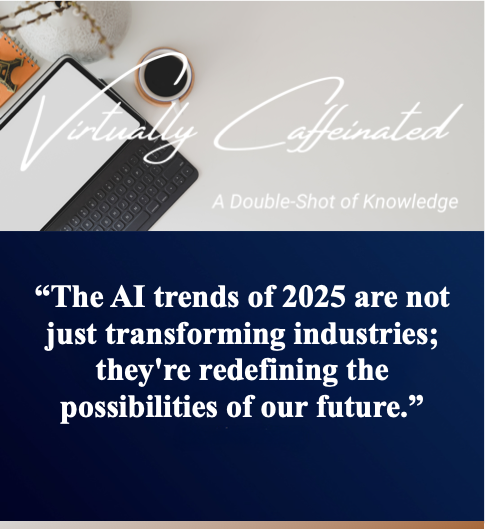AI Trends Shaping the Future in 2025
As we move further into 2025, the role of Artificial Intelligence (AI) in society and industry continues to grow. This is no longer about hypothetical innovations—it’s about the real-world applications that are transforming how we live and work. From revolutionizing healthcare and manufacturing to redefining the creative arts, AI is shaping the future in profound ways.
1. Agentic AI: Towards Autonomous Systems
One of the most exciting developments in AI is the rise of what experts call “agentic AI.” These systems go beyond the basic commands and responses of traditional AI. They’re capable of autonomous decision-making, adapting to new scenarios, and learning from their interactions. Essentially, agentic AI acts as an independent entity that can process complex data, reason through problems, and decide on the best course of action without constant human oversight.
This autonomy makes agentic AI a game-changer. Imagine customer support bots that not only answer questions but can also detect a customer’s frustration level and offer pre-emptive solutions. Think about logistics systems that adjust delivery routes in real-time, factoring in weather, traffic, and supply chain disruptions without needing human intervention. These aren’t just concepts—they’re becoming practical realities that redefine efficiency and innovation.
2. Integration of AI in Robotics: The Rise of Humanoids
Robotics has always been a natural partner for AI, and 2025 is witnessing significant advancements in this area. Humanoid robots—machines designed to move, interact, and even communicate like humans—are stepping out of research labs and into practical roles. Thanks to enhanced AI capabilities, these robots are no longer limited to pre-programmed tasks. Instead, they can learn on the fly, making them valuable across a variety of industries.
In retail, humanoid robots are being used to guide customers, restock shelves, and provide personalized recommendations. In healthcare, they assist with physical therapy exercises, help patients navigate hospitals, and even serve as companions for the elderly. Their ability to understand natural language, read facial expressions, and adapt to changing environments makes them far more than just machines—they become interactive partners in our daily lives.
3. AI in Manufacturing: The Emergence of ‘Dark Factories’
Manufacturing is another sector undergoing a major AI-driven shift. The concept of “dark factories” has gained traction—automated production facilities that can operate without human presence. While this might sound like science fiction, it’s quickly becoming a reality. These factories rely on advanced AI algorithms to coordinate machinery, monitor production lines, and ensure quality control—all without requiring a single lightbulb to be turned on.
The benefits are clear: reduced labor costs, fewer errors, and 24/7 production capability. AI-driven predictive maintenance ensures that machines are serviced before they fail, minimizing downtime. The environmental impact is also reduced as these factories optimize resource use and energy consumption. While some worry about the implications for jobs, the emergence of dark factories also creates opportunities for new roles in AI oversight, system management, and innovation development.
4. AI in Defense: Development of Intelligent Drones
In defense and security, the integration of AI is advancing at a rapid pace. Intelligent drones—equipped with AI to handle navigation, surveillance, and even decision-making—are transforming how missions are conducted. Unlike traditional drones, which rely heavily on human control, these AI-enhanced systems can operate autonomously, making split-second decisions in complex environments.
Whether it’s monitoring borders, conducting reconnaissance missions, or responding to natural disasters, intelligent drones offer a level of efficiency and safety that was previously unattainable. Their ability to analyze data in real time allows them to adapt to changing conditions, detect threats more accurately, and provide critical information to human operators without putting lives at risk. In a world where speed and precision are paramount, AI-driven drones represent a significant leap forward.
5. AI in Creative Industries: Generative AI as a Creative Ally
While AI’s presence in traditionally technical fields is well-documented, its role in the creative arts is just as transformative. Generative AI, in particular, has become a powerful tool for artists, writers, and designers. These algorithms can create entirely new works—generating music, visual art, and even literature—that can stand alongside human creations.
This isn’t about AI replacing human creativity. Instead, it’s about collaboration. Artists are using AI to explore new styles, experiment with innovative techniques, and push the boundaries of what’s possible. Designers use generative AI to quickly prototype ideas, refine their work, and develop concepts that might take weeks or months to produce manually. In this sense, AI acts as a creative ally, opening up new frontiers for expression and innovation.
6. AI in Business: Decision Intelligence
Businesses have always relied on data to make decisions, but the sheer volume and complexity of data available today make traditional approaches inadequate. This is where AI-powered decision intelligence comes into play. By leveraging machine learning algorithms and advanced analytics, businesses can gain insights that were previously hidden in plain sight.
Decision intelligence doesn’t just show what’s happening—it helps predict what’s likely to happen next. It can identify emerging market trends, anticipate customer needs, and optimize supply chains. Companies can use these insights to make more informed choices, reduce risks, and stay ahead of competitors. In a fast-paced world, having AI as a decision-making partner isn’t just advantageous—it’s essential.
7. AI in Public Sector: Enhancing Services
Government agencies and public organizations are also seeing the benefits of AI. By streamlining operations and improving service delivery, AI is helping the public sector address long-standing challenges. For instance, AI-driven chatbots are handling citizen inquiries more efficiently, reducing response times and improving overall satisfaction.
AI is also being used to allocate resources more effectively, ensuring that public services reach those who need them most. From urban planning and traffic management to disaster response and environmental monitoring, the public sector’s adoption of AI is creating smarter, more responsive communities. As governments continue to embrace this technology, citizens can expect a higher quality of life and more transparent governance.
8. AI in Healthcare: Advancements in Diagnostics and Treatment
The impact of AI on healthcare is profound. AI algorithms are now capable of analyzing medical data—such as imaging scans, lab results, and patient histories—to identify diseases earlier and more accurately than ever before. This early detection can make the difference between successful treatment and a more challenging prognosis.
Personalized treatment plans are another area where AI excels. By understanding a patient’s unique genetic makeup, lifestyle, and medical history, AI can recommend therapies and medications tailored to the individual. This approach improves outcomes, reduces side effects, and increases patient satisfaction. As AI continues to evolve, it’s likely to play an even greater role in advancing medical research, improving clinical workflows, and ultimately saving lives.
9. AI in Education: Personalized Learning Experiences
Education is being transformed by AI, particularly when it comes to personalization. No two students learn in exactly the same way, and AI-powered tools are helping educators tailor instruction to meet individual needs. From adaptive learning platforms that adjust content difficulty in real time to virtual tutors that provide targeted assistance, AI is making education more accessible, engaging, and effective.
Students benefit from more focused attention and resources that align with their strengths and weaknesses. Teachers gain valuable insights into student progress, allowing them to intervene early and address challenges before they become major obstacles. As these tools become more widespread, the traditional “one-size-fits-all” approach to education is being replaced by a dynamic, student-centered model.
10. AI in Finance: Enhancing Financial Services
Finally, the finance industry is leveraging AI to improve services, increase security, and optimize investments. AI-powered fraud detection systems analyze transaction patterns to identify suspicious activities in real time, protecting consumers and institutions from financial crimes. Machine learning models are also being used to predict market trends, helping investors make more informed decisions.
Robo-advisors—digital platforms that provide automated, algorithm-driven financial planning—are becoming more sophisticated. These AI tools can assess risk tolerance, suggest portfolio adjustments, and continuously refine investment strategies. As a result, financial services are becoming more accessible to a wider audience, while also providing higher levels of accuracy and personalization.
Conclusion
In 2025, Artificial Intelligence isn’t just a tool—it’s a transformative force driving progress across industries. The trends outlined here—from agentic AI and humanoid robotics to generative creativity and decision intelligence—are shaping a future that’s more efficient, innovative, and inclusive. As AI continues to evolve, it will unlock new possibilities, solve complex challenges, and push the boundaries of what we can achieve. Far from replacing human ingenuity, AI is amplifying it, opening doors to a future that’s not only smarter but also more inspiring.

